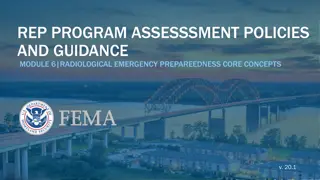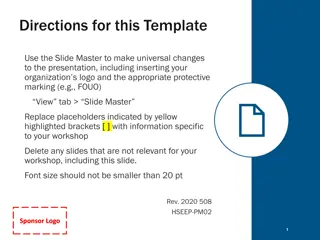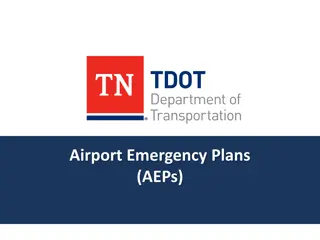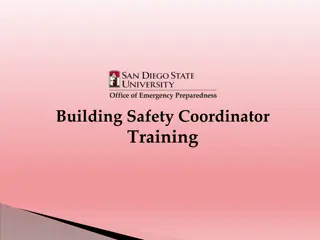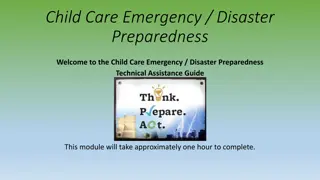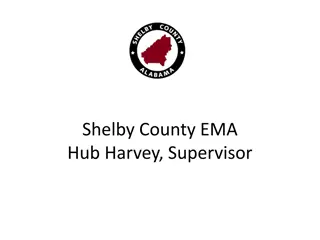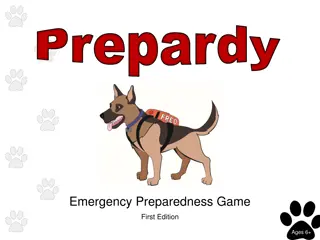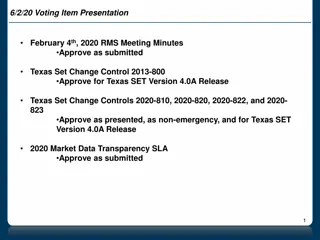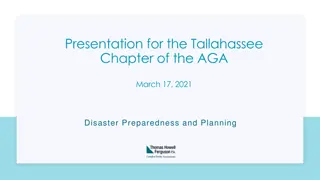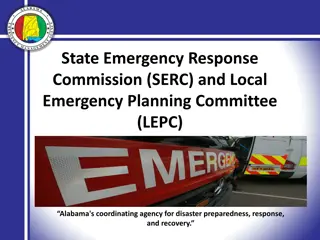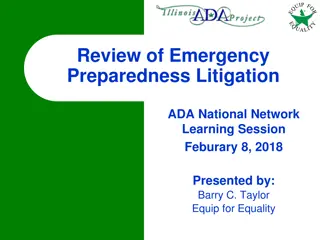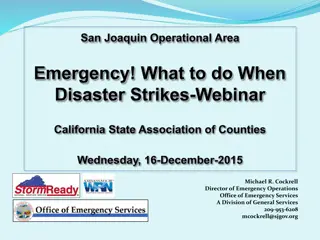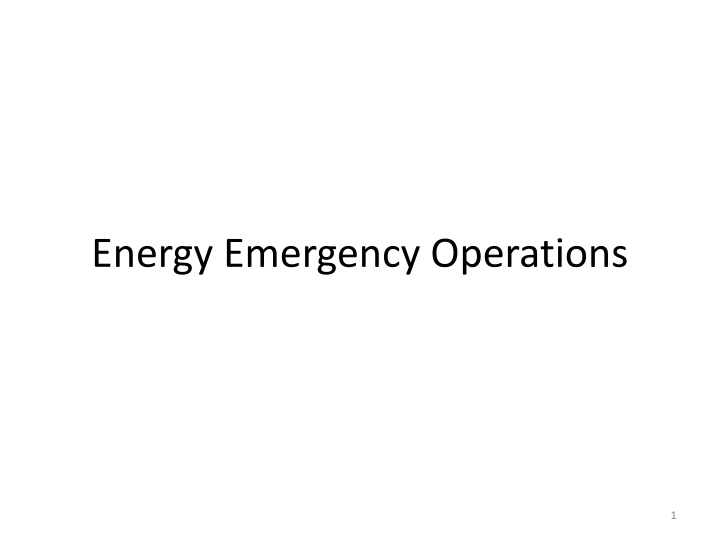
ERCOT Energy Emergency Operations and Alerts
Learn about the role and responsibilities of ERCOT in managing energy emergencies, including the communication protocols, alert levels, and actions taken during different scenarios to ensure grid reliability and prevent power outages.
Download Presentation

Please find below an Image/Link to download the presentation.
The content on the website is provided AS IS for your information and personal use only. It may not be sold, licensed, or shared on other websites without obtaining consent from the author. If you encounter any issues during the download, it is possible that the publisher has removed the file from their server.
You are allowed to download the files provided on this website for personal or commercial use, subject to the condition that they are used lawfully. All files are the property of their respective owners.
The content on the website is provided AS IS for your information and personal use only. It may not be sold, licensed, or shared on other websites without obtaining consent from the author.
E N D
Presentation Transcript
ERCOT Role & Responsibilities 2
ERCOT Energy Emergency Alert Communications Automated Emergency Notifications Follow-up Communications from ExternalAffairs Media/Public Notifications EmergencyLevels* Trigger Grid Operators' Actions Reserves >3,000MW Normaloperations Normal Conditions Issue "OCN" to utilities informational only Control Room Operating Condition Notice (OCN) Projected need for additional resources Public Utility Commission of Texas (PUC) and NERC regional entity (Texas Reliability Entity (Texas RE)) notified via dailyemails Used rarely, as needed, to encourage conservation when tight operating reserves are expected to be a reliabilityconcern Monitor need for additional generation and voluntary demand response resources None conservation messages entered and deployed manually in non-emergency situations Coordinate public notification with PUC staff; notify media and market participants media contacts/PIOs of change in conditions Spotlight on home page of ercot.com and mobile app; social media posts; app messages and/or news release ConservationAlert Issue "Advisory" to utilities informational only Reserves <3,000MW PUC and Texas RE notified via daily emails; operations notices at control room discretion ControlRoom Advisory Reserves <2,500MW Use quick-start capacityand release non-spinning reserves (available within 30minutes) Automated Emergency Notification System phone call and email to PUC staff, the Independent Market Monitor (IMM), Texas RE and FERC; operations notice at control room discretion If potential emergency situation, additional information sent to SOC, PUC, OPUC, RRC, TCEQ,ERCOT Board, Government/Legislature, IMM, Texas RE, FERC and market participants' media contacts/PIOs Considerconservation alert to support grid reliability ControlRoom Watch Use additional capacity available from other grids (via DC Ties; 500 MW on average) and commit all available units; implement weather-sensitive and 30-minute Emergency Response Service (ERS)** resources and TDSP Load Management programs if needed. Deploy Responsive Reserves if PRC<2000. Reserves <2,300 MW and not expected to be recovered within 30 minutes Above plus State Operations Center (SOC) (notifies city, county officials & law enforcement), Office of Public Utility Counsel (OPUC), Government/Legislature staff and ERCOT Board; media contacts forutilities If needed, notify grid emergency lists with additionalinformation Emergency Alerts list***, Twitter and Facebook, mobile app alerts; spotlight on ercot.com and mobile app; news release if appropriate EnergyEmergency Level 1 POWER WATCH- Conservation Needed Frequency cannot be maintained above 59.91 Hz or Physical Responsive Capability (PRC) <1,750 MW and not expected to be recovered within 30 minutes Deploy demand response resources: Load Resources under contract (typically ~1,150 MW) and/or remaining ERS** (currently 1,123 MW on peak), in either order. Begin block load transfers of load to other grids if appropriate. Above, plus major news services Same asabove Same asabove EnergyEmergency Level 2 POWER WARNINGA- Conservation Critical Same asabove Same asabove Same asabove Frequency cannot be maintained above 59.91 Hz or PRC cannot be maintained >1,375MW Ensure all resources allowed under EEA 2 are deployed EnergyEmergency Level 3 POWER WARNING B- High Risk of RotatingOutages Frequency cannot be maintained above 59.91 Hz or PRC <1,000MW and not expected to be recovered within 30 minutes Instruct transmission operators to implement rotating outages; areas affected are at the discretion of theutilities Emergency Alerts list, Twitter and Facebook, mobile app alerts; spotlight on ercot.com and mobile app; issue news release; activate call center if needed Same asabove Same asabove EnergyEmergency Level 3 POWER EMERGENCY- Rotating Outagesin Progress 5 *Depending on system conditions overall, ERCOT Operations has some discretion regarding emergency levels and specific actions, based on these guidelines. **Emergency Response Service (ERS) may include 10-minute, 30-minute and Weather-Sensitive Demand Response resources. ***Sign up for Emergency Alerts and News Bulletins email lists at http://lists.ercot.com
Nodal Protocol 6.5.9, Emergency Operations NP 6.5.9.3(2) Communication under Emergency Conditions The type of communication ERCOT issues is determined primarily on the basis of the time available for the market to respond before an Emergency Condition occurs. The timing of these communications could range from days in advance to immediate. If there is insufficient time to allow the market to react, ERCOT may bypass one or more of the communication steps. 1) Operating Condition Notice (OCN) [NP 6.5.9.3.1] 2) Advisory [NP 6.5.9.3.2] 3) Watch [NP 6.5.9.3.3] 4) Emergency Notice [NP 6.5.9.3.4] Note: TAC-approved greybox language associated with NPRR857 clarifies additional responsibilities throughout NP 6.5.9. Greybox language for NPRR930 introduces the Advanced Action Notice (AAN) process that will be inserted in NP 6.5.9.3.1.1 upon system implementation. 6
Nodal Protocol 6.5.9.3.4, Emergency Notice (2) ERCOT shall issue an Emergency Notice for one or both of the following reasons: (a) ERCOT cannot maintain minimum reliability standards (for reasons including fuel shortages) during the Operating Period using every Resource practicably obtainable from the market; or (b) Immediate action cannot be taken to avoid or relieve a Transmission Element operating above its Emergency Rating. (3) The actions ERCOT takes during an Emergency Condition depend on the nature and severity of the situation. (5) If the Emergency Condition is the result of a transmission problem, ERCOT shall act immediately to return the ERCOT System to a reliable condition, including instructing Resources to change output, curtailing any remaining DC Tie Load, and instructing TSPs or DSPs to drop Load. 7
TDSP/DSP Role & Responsibilities 8
ERCOT will declare EEA levels according to available Physical Responsive Capability (PRC) MW reserves, and will take the steps outlined in NOG 4.5.3.3, EEA Levels, to maintain steady state system frequency near 60 Hz and restore PRC appropriate for each EEA level. When the TDSP/DSP receives Energy Emergency Alert (EEA) Load Shedding instructions from ERCOT, the TDSP/DSP s responsibility is to perform all necessary actions as prescribed in the ERCOT Nodal Operating Guides (NOG) Section 4, Emergency Operations within the timelines as specified throughout this section. Section 4: Emergency Operation 9
Example: Timing of ERCOT Instructions to TDSPs Initial Instructions: ERCOT will instruct TDSP/DSPs to shed X MWs on the Distribution System within 30 minutes. Follow-up Instructions: After completing the initial 30 minute instruction, ERCOT operator may continue with further instructions if the PRC has not been restored. Follow up instructions can range from ten (10) to thirty (30) minute durations with specific instructions for TDSP/DSPs to continue load shedding procedures until ERCOT declares the EEA event has been terminated (see slide 12-13) Note: TDSPs rotate outages on the Distribution system only. The Transmission system is not subject to rotating outages. 10
Nodal Operating Guide 4.5.3.5, EEA Termination (1) ERCOT shall: (a) Continue EEA until sufficient Resources are available to ERCOT to eliminate the shortfall and restore adequate reserves; (b) Restore full reserve requirements (normally 2300 MW); (c) Terminate the levels in reverse order, where practical; (d) Notify each QSE and TO of EEA level termination; and (e) Maintain a stable ERCOT System frequency when restoring Load. (2) QSEs and TOs shall: (a) Implement actions to terminate previous actions as EEA levels are released in accordance with these Operating Guides; (b) Notify represented Market Participants of EEA levels changes; (c) Report back to the ERCOT System Operator when each level is accomplished; and (d) Loads will be restored when specifically authorized by the ERCOT. 13
Additional ERCOT Communications Information Reference Information: Tips for Conservation: http://ercot.com/about/conservation ERCOT EEA Communications Matrix: http://www.ercot.com/content/wcm/lists/144929/ERCOT_Energy_Emergency_Ale rt_Communications_Matrix_May_2018.pdf ERCOT EEA Tools One-Pager: http://www.ercot.com/content/wcm/lists/190195/EEA_Tools_OnePager_ FINAL.PDF 14
Questions? 15

